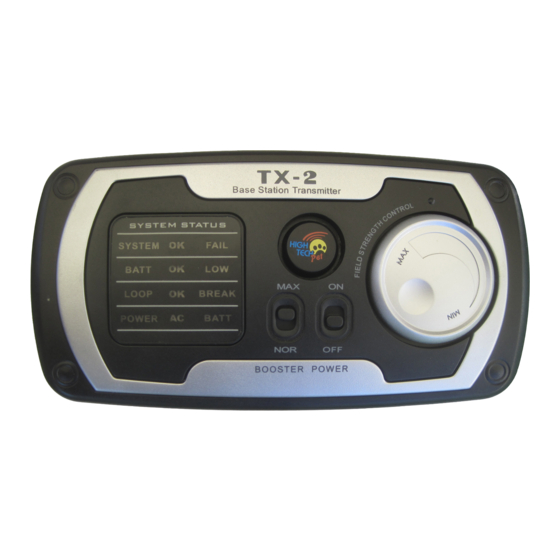High Tech Pet Bluefang TX-2 Manual de instalação, funcionamento e formação - Página 7
Procurar online ou descarregar pdf Manual de instalação, funcionamento e formação para Produtos para animais de estimação High Tech Pet Bluefang TX-2. High Tech Pet Bluefang TX-2 9 páginas. Electronic fence

Splicing the Boundary Wire: You may find the included improved waterproof
wire splices useful in connecting individual lengths of wire or twisted wire. To
use these connectors: Additional splices are available from ww.hightechpet.com
Test Your System
Switch the Base Station Transmitter ON. Take your Receiver Collar and walk the
entire boundary ensuring that the collar continues to beep along the entire
perimeter. Also check the lengths of twisted wire to make sure that the field is
inactive in the areas where they are used. If the collar picks up a signal from the
twisted length, the basic layout is probably incorrect – review the discussion of
single and double loop layouts. If you are using a single loop layout, twisted wire
can only be used at the base station, or at the feed from the primary loop to
another primary loop (example: small loop within a large loop).
Bury the Boundary Wire
You do not have to bury the wire for the Humane Contain System to operate
however, for protection of the wire, we recommend that you bury it at least 2
inches, and no more than 4 inches deep. Using a flat spade or rotary blade power
lawn edger, make a narrow trough around the path of the loop. Using gradual
turns at the corners will produce a more consistent signal field. Because of its
advanced digital electronics, stray radio signals are unlikely to cause false
activation of the collar. However, we recommend that you stay at least six feet
away from electrical, telephone, cable TV and other buried wires. These can
cause attenuation or dead spots in your field. Large metal objects may create
reflected signals from the boundary wire itself. You should avoid running the wire
near such structures. If your neighbor has an electronic dog fence you should bury
the wire at least ten feet away.
Crossing a Driveway or Walk
When crossing a driveway or sidewalk, you may be able to find an
expansion joint into which you can place the wire. Remove any calking
material in the joint, place the wire and re-caulk. If an expansion joint is not
available, you can make a ½ inch deep narrow slit across the drive or walk
using a circular power saw and masonry blade. Place the wire in the slit and
seal with outdoor silicone caulk of matching color. Use asphalt sealant for
asphalt driveways. Another option is High Tech Pet's new optional Driveway
Traverse Strip, which easily crosses driveways and walks with your
electronic fence wire. This durable rubber slit attractively covers and protects
the pet fence wire. You can drive over it, walk over it, even mow over it
with no damage to the underlying boundary wire. Made of super durable
elastomer, that will last years and years, it takes only minutes to install.
To order, go to http://www.hitecpet.com/dts-1.html or from our main page
www.HighTechPet.com search "Driveway Crossing Strip".
Crossing Gravel
When crossing gravel, run the wire through a hose or PVC pipe and then bury
at least three inches deep.
Crossing Water
To cross a stream or body of water, run the wire through a hose or PVC
pipe. Anchor each end using large rocks or other stationary objects.
Place the Boundary Flags
Boundary flags are provided so that your pet can easily see the boundary
perimeter. This is especially important during training. Flags should be placed
along the entire perimeter spaced no more than ten feet apart. Using a fully
matching color. Use asphalt sealant for asphalt driveways.
12
13
